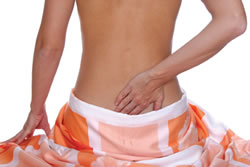HEALTH - FOCUS ON YOUR HEALTH
Live Better!
Your Aching Back
September, 2006 - Issue #23
 |
My most frustrating moment as a dancer came when two discs decided to herniate. My fellow dancers highly recommended a certain physical therapist. I went with very high hopes, but left completely morose. She asked me if I could touch my toes. (What would your guess be?) My frustration began to build. Then she walked to a filing cabinet, pulled out a folder marked "Back Pain Exercises" and handed it over. It still aggravates me that I had to reinvent the wheel to heal my back.
It's true that there are some general rules of thumb to check out when it comes to back pain. First, there's the diagnosis. What are the doctors, x-rays and MRIs saying about your back? Most importantly, what are you feeling and experiencing? I thought MRIs saw everything there was to see but that is not the case, according to Dr. Stuart McGill, a kinesioligist and the director of the Spine Biomechanics Laboratory in Toronto.
| Struggling with Back Pain?
• Stop doing the same old stretches • Find the exacerbating factor • Strengthen your spine and abdominals • Fix the biomechanics |
If medical text books aren't your style, here are some simplistic translations. McGill's studies show that for most back pain, you need to stop doing the stretches you've been doing. For most of us with back pain, there are more effective stretches/exercises that will give you more permanent relief. In fact, the stretches and exercises that do the most amounts of good don't seem to have anything to do with the back.
Our next focus for healing an unhappy spine and a big focus of McGill's work is getting rid of exacerbating factors. Is there an exacerbating repetitive activity that's causing the pain? Are you carrying heavy loads (small children included)? How's your posture? Sometimes it is not even something we are aware of doing and it takes a trained eye to point it out. To change an unhealthy movement pattern is a re-education process. I remember a dance instructor telling me that for something to "stick," a student had to be reminded between 30 and 50 times.
According to the National Institute of Health (NIH), acute back pain (Remember when you lifted a block of concrete and got a serious "hello" from your back?) will subside substantially within 72 hours of self-care. Don't treat this type of back pain with bed rest for more than one to two days. Also keep in mind that exercise promotes the speediest recovery of back pain - that's not from me, that's from the NIH.
The NIH also recommends abdominal and spine strengthening. Did you just hear me heavily sigh? My patients misinterpret this last statement about abdominal and spine strengthening. First, they throw the spine strengthening completely out the window, never to be seen again. Secondly, abdominal crunches are the worst ab strengthener for your sore back. However, other alternatives are available.
I have to close with an apology. I wish I could include even one exercise to get you started. But again, back pain is not one-size-fits-all and there is not enough paper to possibly assist all the assorted issues of all of our readers. Find someone who will work with you as an individual and, most importantly, is qualified to help you.
--------------------------------------------------------------
Karena Lineback is the author of "OsteoPilates" and president of Pilates Teck.
|
||||||||||||||||||||||||||||





